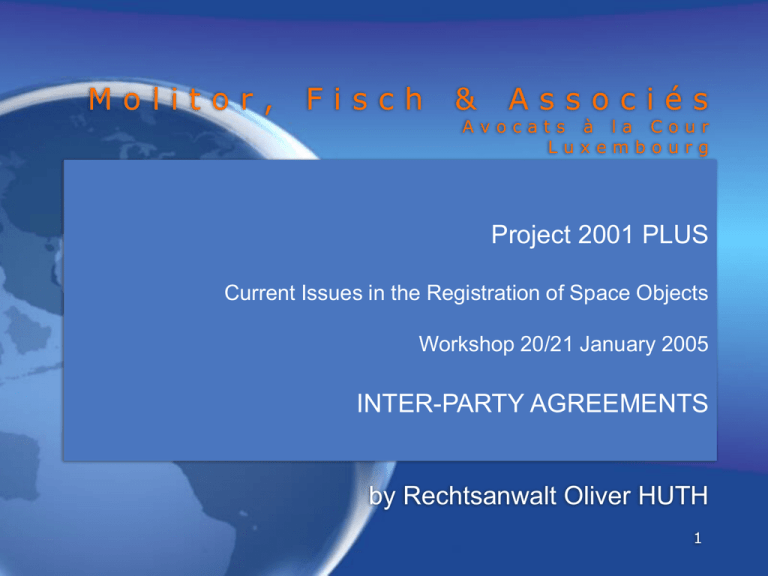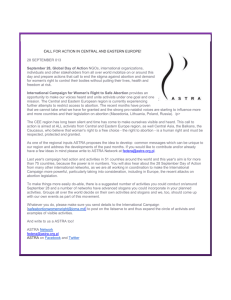Inter-Party Agreements
advertisement

Molitor, Fisch & Associés Avocats à la Cour Luxembourg Project 2001 PLUS Current Issues in the Registration of Space Objects Workshop 20/21 January 2005 INTER-PARTY AGREEMENTS by Rechtsanwalt Oliver HUTH 1 I. References to « Inter-Party Agreements » • Art. II 2. of the Registration Convention : « Where there are two or more launching States in respect of any such space object, they shall jointly determine which one of them shall register the object in accordance with paragraph 1 of this article, bearing in mind the provisions of article VIII of the Treaty on Principles Governing the Activities of States in the Exploration and Use of Outer Space, including the Moon and Other Celestial Bodies, and without prejudice to appropriate agreements concluded or to be concluded among the launching States on jurisdiction and control over the space object and over any personnel thereof. » 2 I. References to « Inter-Party Agreements » Art. VI of the Registration Convention: request for assistance in the identification of a space object having caused damage « (…) A State Party making such a request shall, to the greatest extent feasible, submit information as to the time, nature and circumstances of the events giving rise to the request. Arrangements under which such assistance shall be rendered shall be the subject of agreement between the parties concerned .» 3 II. Inter-Party Agreements and the Liability Convention • • • • Interaction between RC and LC Need to be read and interpreted together Launching State must register Aim/goal of the RC : – facilitating the identification on the Launching State in view of liability – Facilitating evidence for a victim of a damage 4 II. Inter-Party Agreements and the Liability Convention • Art. V 2 : «(…) The participants in a joint launching may conclude agreements regarding the apportioning among themselves of the financial obligation in respect of which they are jointly and severally liable. Such agreements shall be without prejudice to the right of a State sustaining damage to seek the entire compensation due under this Convention from any or all of the launching States which are jointly and severally liable. » 5 II. Inter-Party Agreements and the Liability Convention Art. XXIII 2 : « No provision in this Convention shall prevent States from concluding international agreements reaffirming, supplementing or extending its provisions » 6 III. Inter-Party Agreements in the framework of the UN space law system • Inter-Party Agreements : – can include both aspects of registration and liability – other issues – can be concluded for specific space objects/launches or provide for general terms and conditions (framework agreements) 7 III. Inter-Party Agreements in the framework of the UN space law system • Note Art. V 2, last sentence of the LC: « Such agreements shall be without prejudice to the right of a State sustaining damage to seek the entire compensation due under this Convention from any or all of the launching States which are jointly and severally liable. » • Same consequence from the victim’s point of view where there is an IPA regulating the registration : recourse against any and all of the launching States is not excluded 8 III. Inter-Party Agreements in the framework of the UN space law system • Party ? – States party to the respective Conventions, Launching States – Not : private entities – Under Registration Convention : States Party to the Registration Convention and being Launching States – UN space treaties • Only States are parties (special provisions for international organisations - concept of declaration of acceptance) 9 III. Inter-Party Agreements in the framework of the UN space law system • Launch contracts signed between operators and launch service providers have no effect on joint and several liability regime installed by the UN treaties • No effect of such contracts for recourse of a Launching State against « its » nongovernmental entities 10 IV. Inter-Party Agreements and practice • Multitude and variety • Famous example : Article 5 of the Agreement « concerning cooperation on the civil international space station » (IGA): « 1. In accordance with Article II of the Registration Convention, each Partner shall register as space objects the flight elements listed in the Annex which it provides, the European Partner having delegated this responsibility to ESA, acting in its name and on its behalf. » 11 V. Luxembourg and space law • Luxembourg a State Party to : – the Liability Convention • Not ratified – Outer Space Treaty – Registration Convention – Moon Agreement – Agreement on the Rescue of Astronauts 12 V. Luxembourg and space law • Contradiction to reality : – Luxembourg de facto a major space-faring nation • Launching State • Following slides : Courtesy of SES GLOBAL/SES ASTRA 13 SES ASTRA • Operator of ASTRA, the leading DTH broadcast satellite system in Europe • ASTRA consists of 13 satellites at 4 orbital positions – ASTRA transmits more than 1,400 digital and analogue channels on behalf of leading European and international broadcasters – ASTRA serves 94 million homes in 30 European countries • 36.4 million homes in DTH reception • 57.9 million homes via cable (Courtesy: SES GLOBAL/ SES ASTRA) 14 SES GLOBAL • The world’s leading satellite operator by revenues, EBITDA and size of fleet • Born out of the combination of SES ASTRA and SES AMERICOM – ASTRA: No.1 DTH broadcast satellite system in Europe with a reach of approx. 36.4 million households (94 million incl. cable) – AMERICOM: Leading position in US cable head-end broadcasting serving over 10,000 head-ends with reach of approximately 80 million cable households (Courtesy: SES GLOBAL/ SES ASTRA) 15 Global reach based on regional market focus SES ASTRA is Europe’s #1 satellite service provider reaching some 94 million households SES AMERICOM is a major player in broadcasting for US cable services reaching some 80 million US households 16 (Courtesy: SES GLOBAL/ SES ASTRA) The SES GLOBAL Fleet (Courtesy: SES GLOBAL/ SES ASTRA) Largest satellite fleet with 40 satellites: 29 operated by wholly owned subsidiaries and 11 through equity participations Located at 30 orbital positions ASTRA services at a glance (Courtesy: SES GLOBAL/ SES ASTRA) Video – DTH and cable 18 ASTRA services at a glance (Courtesy: SES GLOBAL/ SES ASTRA) Video – DTH and cable Radio – DTH and cable 19 ASTRA services at a glance (Courtesy: SES GLOBAL/ SES ASTRA) Video – DTH and cable Radio – DTH and cable IP Services 20 ASTRA services at a glance (Courtesy: SES GLOBAL/ SES ASTRA) Video – DTH and cable Radio – DTH and cable IP Services Enterprise networks 21 ASTRA services at a glance (Courtesy: SES GLOBAL/ SES ASTRA) Video – DTH and cable SNG/Occasional use Radio – DTH and cable IP Services Enterprise networks 22 ASTRA services at a glance (Courtesy: SES GLOBAL/ SES ASTRA) Video – DTH and cable SNG/Occasional use Radio – DTH and cable Government services IP Services Enterprise networks 23 ASTRA services at a glance (Courtesy: SES GLOBAL/ SES ASTRA) Video – DTH and cable SNG/Occasional use Radio – DTH and cable Government services IP Services TechCom services Enterprise networks 24 The ASTRA satellite fleet (Courtesy: SES GLOBAL/ SES ASTRA) 25 ASTRA coverage area in Europe (Courtesy : SES GLOBAL/SES ASTRA) 26 Blue chip customers ASTRA transmits more than 1,400 channels on behalf of Europe’s leading broadcasters via its satellites at 19.2° and 28.2° East V. Luxembourg and its registration practice • Competent authority : Service des Médias et des Communications • Practice of voluntary registration – Voluntary acceptance of RC and relevant UN resolutions • Resolutions 1721(XVI) of December 20, 1961 and 41/66 of December 3, 1986 • No national registry • Update and regrouped registration every 2-3 years 28 V.Luxembourg and IPAs • No such agreements in place • However, informal practice – Example : Cooperation with the Russian Federation • Russian Federation includes certain minimum details about ASTRA satellites in its registration data when launching Proton rockets from Baikonur 29 V. Luxembourg : Current developments • Ratification of UN Conventions and national space law – Process accelerated by the problems occurred with ASTRA 1-K • Actual risk of damage if safe deorbiting of ASTRA 1-K had failed (Dec. 2002) – Ratification of OST in June 2005 (current preparatory work) 30 V.Luxembourg : Current developments • • • • • Elaboration of a national space law In parallel : ratification of the RC is envisaged Need for IPAs has been recognized Eventually : plans to approach COPUOS Luxembourg soon ESA Member State – Agreement on accession to the ESA convention signed May 6, 2004 31 VI. Examples/applications of IPAs • Agreement between the Government of Australia and the Government of the Russian Federation on Cooperation in the Field of the Exploration and Use of Outer Space for Peaceful Purposes (23 May 2001) • Main clause : cross-waiver of liability for certain cases • Background of the agreement : – The import of sophisticated, foreign launch vehicle and other space-related technologies involves the agreement between governments for its release and access control, especially given the sensitive basis of some of the technologies involved. The key provisions include protection of intellectual and physical property and information. 32 VI. Examples/applications of IPAs : The case of Hellas SAT • Hellas Sat Consortium Ltd. and Hellas SAT S.A. signed two contracts with SES ASTRA S.A. covering the Hellas Sat satellite (« Olympic Bird ») manufactured by Astrium (France) • ASTRA provided TT&C services and installed and integrated two ground control stations for Hellas Sat • Launch on ATLAS V on May 13, 2003 33 VI. Examples/applications of IPAs : Hellas SAT • For a period of 12 months, SES ensured full control of the satellite from its HQ in Betzdorf, Luxembourg GREECE Hellas Sat Consortium Ltd. Hellas Sat S.A. ASTRIUM (France) <SES ASTRA S.A.> OTE (operator ground station) in Thermopylae Greece 34 VII. Specific problems • Can a non launching State register a space object ? • IPAs to this effect and in view of transfering jurisdiction and control possible ? • Obligation of the new owner to register ? • Liability of the registering non launching State by the sole fact of its registering ? 35 VII. Specific problems • Reluctancy to conclude IPAs with regard to the registration obligation ? – One Party will expose itself to more attention – Only makes sense in conjunction with an appropriate IPA with regard to apportioning of liability 36 VIII. Conclusions • Given the current concept of Launching State, the principle of joint and several, absolute liability, the obligation of the Launching State having to register : – Necessity for IPAs, as a current amendment to Liability and Registration Convention seems unrealistic 37 VIII. Conclusions • IPAs regulating liability issues will almost « naturally » also deal with registration issues (annex issue) • More legal « security » of States Parties • IPAs regulating registration « less urgent » than those regulating liability 38 VIII. Conclusions / open issues • General framework IPAs or specific IPAs for every joint mission/ launch ? – Advantages /disadvantages • Harmonization and non-contradiction between IPAs and contracts concluded by the major private operators and entities 39 VII. Conclusions • Europeanization of the questions pertaining to IPAs ? New law developments under European Constitution ? • Art. 13 of the new Constitution - room for such developments ? • Depends on ESA/EU relationships 40 Molitor, Fisch & Associés Avocats à la Cour Luxembourg Thank you for your attention ! oliver.huth@mfa.lu 8, rue Sainte-Zithe, B.P. 690, L-2016 Luxembourg 41




